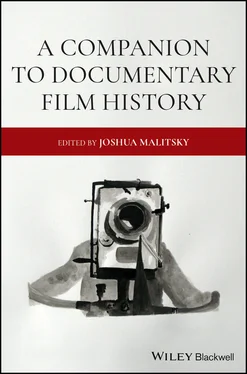If CAD’s early films were as interested in the image of democracy in action as they were in seeing it actually practiced, Social Change in a Democracy (1951) was intended to illustrate how democracies were different from totalitarian societies. The film was produced by the New York firm Sun Dial Films, Inc., which was incorporated in 1944 and headed by Samuel Datlowe, who made B‐movies before turning to the nontheatrical field after the war. 27 Although the script itself did not indicate a specific setting for the film, H. M. Lambert, a production manager for the company, was sent by the company to Biloxi, Mississippi, presumably because of its fishing industry. The local newspaper in Biloxi emphasized the fact that the picture was for Japanese audiences. As Lambert told the local newspaper, it was intended to “show how the people in a democratic fishing town overcome a local problem by democratic methods.” 28 Like the other films discussed in this chapter, the film used local actors, who were asked to give freely of their time and other resources for government benefit. The Biloxi Chamber of Commerce assisted with the casting of students in exchange for an English‐language 35 mm print of the film, and, according to the newspaper, “local boat owners … agreed to let the company film their boats and plants as scenic backdrops for the movie, which will also include scenes of classrooms, and of the mayor and local administrators at work.” 29 The film was directed by Joseph Henabery, best known for his portrayal of Abraham Lincoln in D.W. Griffith’s The Birth of A Nation (1915). 30
Despite the film’s Southern setting and provocative title, Social Change in a Democracy does not address the struggle for civil rights for African Americans in the American South, a political movement that garnered international attention in the late 1950s and 1960s. Instead, the “social change” with which the film is concerned is narrower in scope. Like Women and the Community , Social Change opens with a series of shots of its setting, in this case the residential and business districts of Biloxi. From the outset, the script emphasizes the contradiction at the heart of many of these films, as the narrator notes:
Every small town in the United States has its own special character – it is unique – quite unlike any other place in the world. But in a larger sense, each small town can be taken as typical of many other small focal points of population in America. There is the same easy space, the same unity of culture, tradition, background – a cohesiveness of society.
Like Women and the Community , Social Change makes a sharp transition from an overly generalized look at small‐town life to a lecture in a high school civics class on the subject of democracy. In this case, the lecture, on the “philosophy of government,” is delivered by a teacher who is particularly adept at drawing on the chalkboard. In the lecture, the teacher first criticizes what the narrator calls a “pyramid” structure of government, in which all decisions are made by a few people at the top. In contrast, a democratic government is portrayed as a “kind of house designed to shelter and protect citizens.” While pyramid‐style governments offer little hope to those who are unhappy with their lot, the narrator argues that the “house of democracy” has a “workshop – available to all citizens – in which significant changes in the structure can be made – changes designed to satisfy the growing needs of the people.” A close‐up of a chalk drawing of a house, with one stick figure holding a hand saw while another holds a hammer, makes literal this image of a house of democracy, which seems primarily to serve as a support for the narrator’s next point – “citizens never change the basic foundation of a house,” such as laws that guarantee freedom of speech, assembly, and the right to vote. The fact that this scene is shot in a segregated school is not commented on in the film itself, and the absence of African Americans in this film, and the absence of racial or ethnic minorities in other small‐town films, suggests that its democratic vision is implicitly linked to whiteness. However, even if someone was not aware that this film was shot in Mississippi, which was a focal point for civil rights activists, the absence of nonwhites becomes a more prominent issue when the teacher shows a 16 mm film about the rise of Nazi Germany as an example of what happens in a “pyramid” government.
This film, which has a March of Time ‐style narration, includes images of concentration camps and several reaction shots of the students that reveal their discomfort with seeing this footage, perhaps for the first time. But instead of analyzing Nazism as a belief system, Social Change argues that the government failed because it made the “welfare of the state superior to the welfare of the people.” This assumption allows the film to argue for a process‐oriented vision of government in which democracy, “ever sensitive to the needs and pressures of the people,” is able to resolve conflict between social groups.
After these long civics lessons, the film returns to Biloxi and to the conflict that is to be resolved through democratic action. As the narrator explains, several years earlier a factory had opened in the community, bringing jobs to the region, but “as a part of the plant’s operation, a waste material was being discharged into the bay – a foreign substance pouring into the salt water for two years.” Over time, the pollution began to impact the shrimp population, and thus the fishermen who relied on shrimping for their income. As was the case with the other two films, this initiative begins as something organized by a group of private individuals. In this case, the fishermen raise money to hire “experts, scientists, to investigate” the cause of the decline in the shrimp population. Although this problem is, first, an environmental one, the use of close‐up of the fishermen’s faces suggests that it is the interpersonal conflict that is most critical here. Medium and long shots of the private investigators show them collecting water samples and determining that the factory pollution has hurt the food supply for the shrimp. After learning this news, the fishermen approach the plant manager, who is unsympathetic to their plight.
The fishermen’s first response is to destroy the plant – as the narrator notes, “these are simple people. Violence seems to be their only solution” – but then one fisherman, identified as a veteran, suggests a democratic solution instead. Once again, the local government, here identified as the “Board of Selectmen,” is offered as the institution that can resolve this conflict. The film’s reference to a governmental structure most common in New England is only further evidence that there was little thought given to the production location of Social Change , which is a shift from both earlier CAD films and, in particular, those made by the OWI and the CI‐AA, which wished to explore the particularities of American places and people. At the meeting, the town’s elected officials realize that, as the narrator observes, “what began as a dispute between two small groups in the community has grown into a recognition of a basic evil, menacing the entire community,” and must be addressed by the town, which now plans to build a “sewage disposal plant” with taxpayer dollars. Instead of this action being seen as absolving the factory of any responsibility for its own pollution, the narrator argues that collectivizing the cost of pollution benefits all. The film ends with a shot of three fishing boats on the water, suggesting that the waters were made safe again by the government’s action.
Читать дальше












